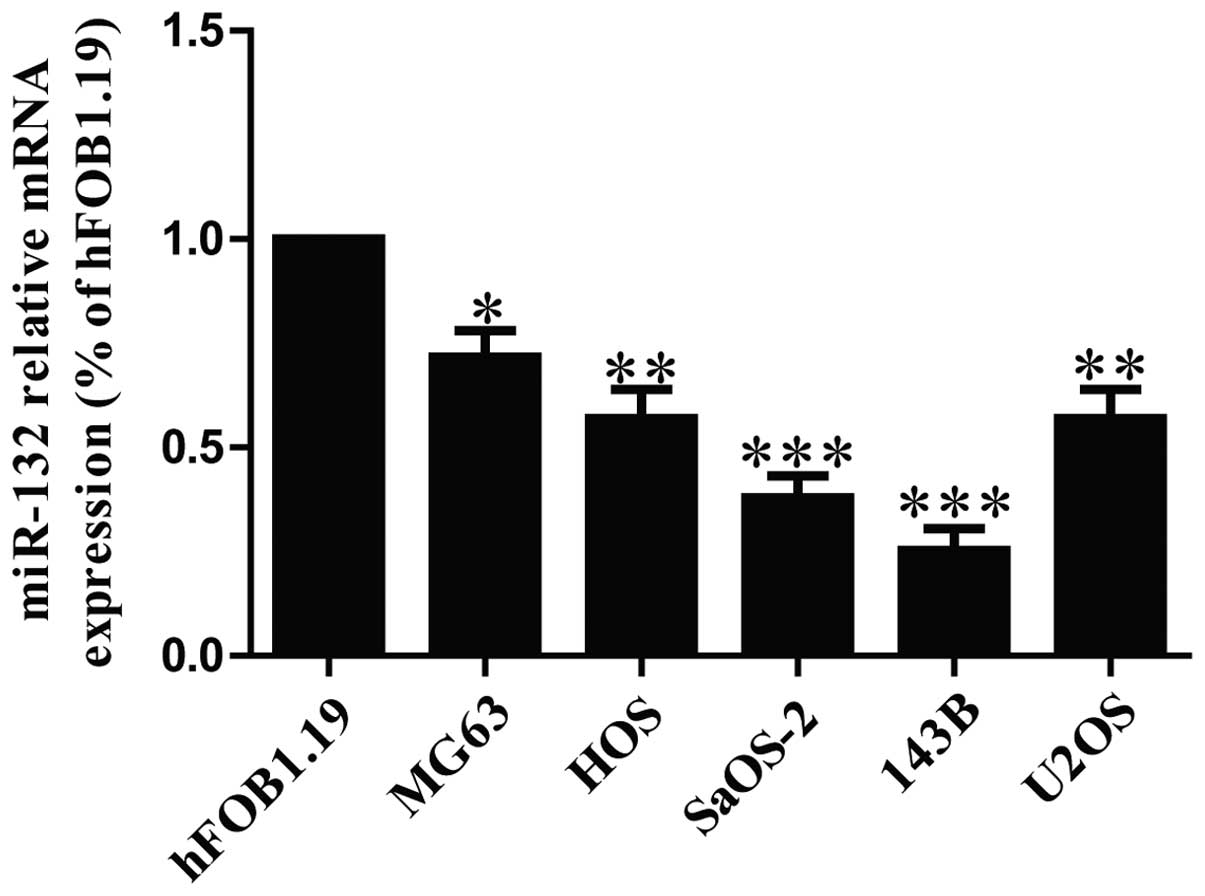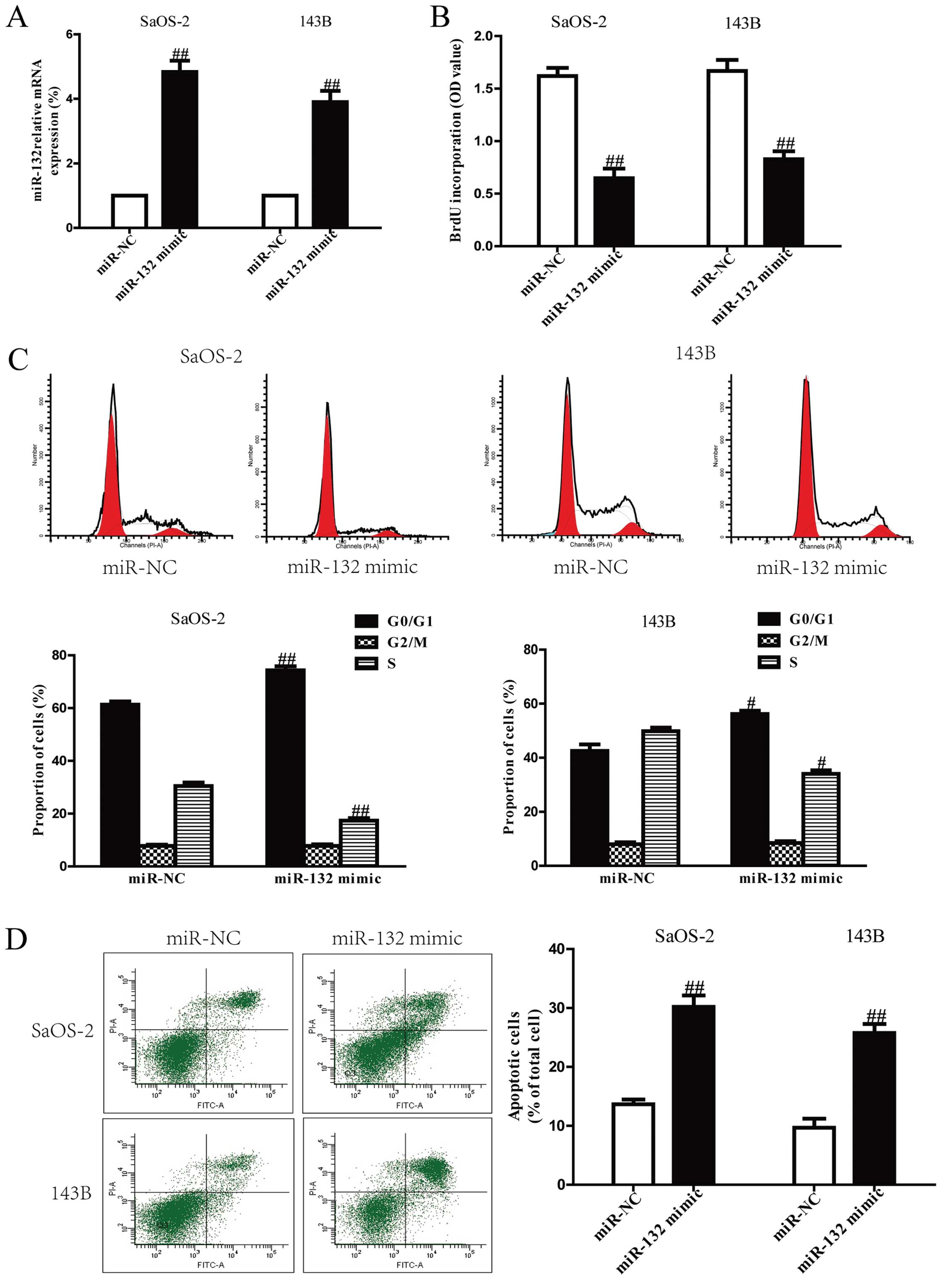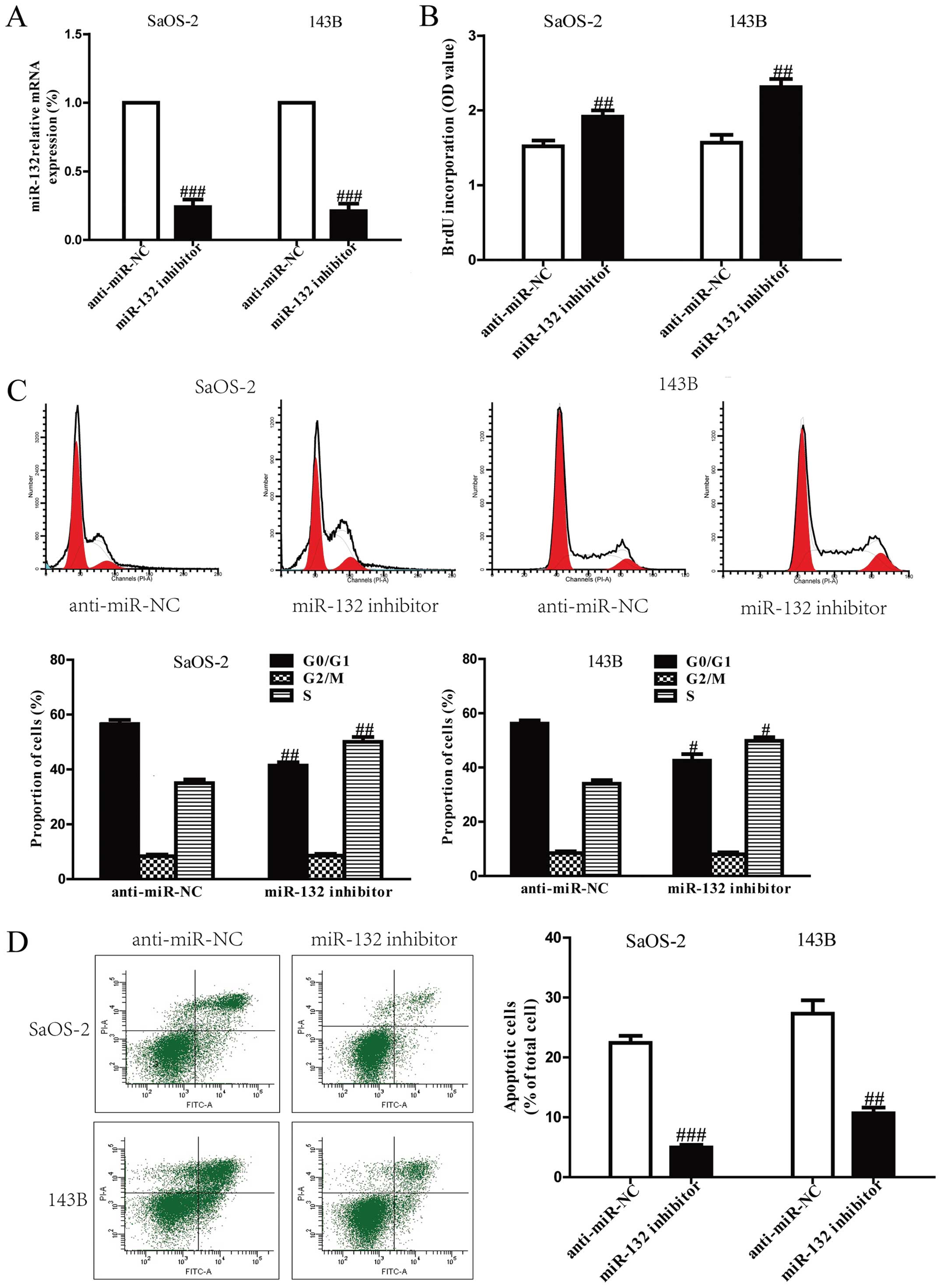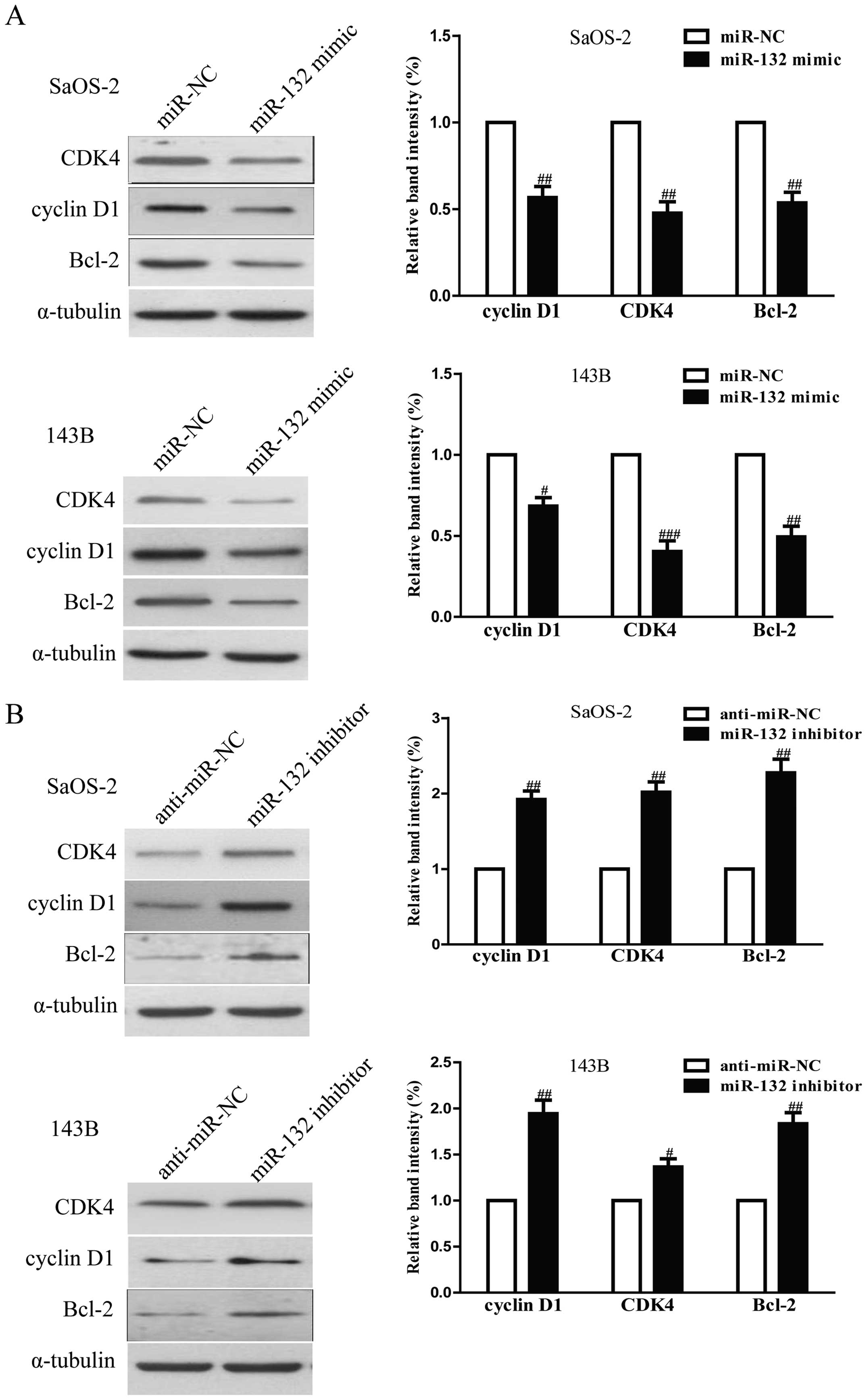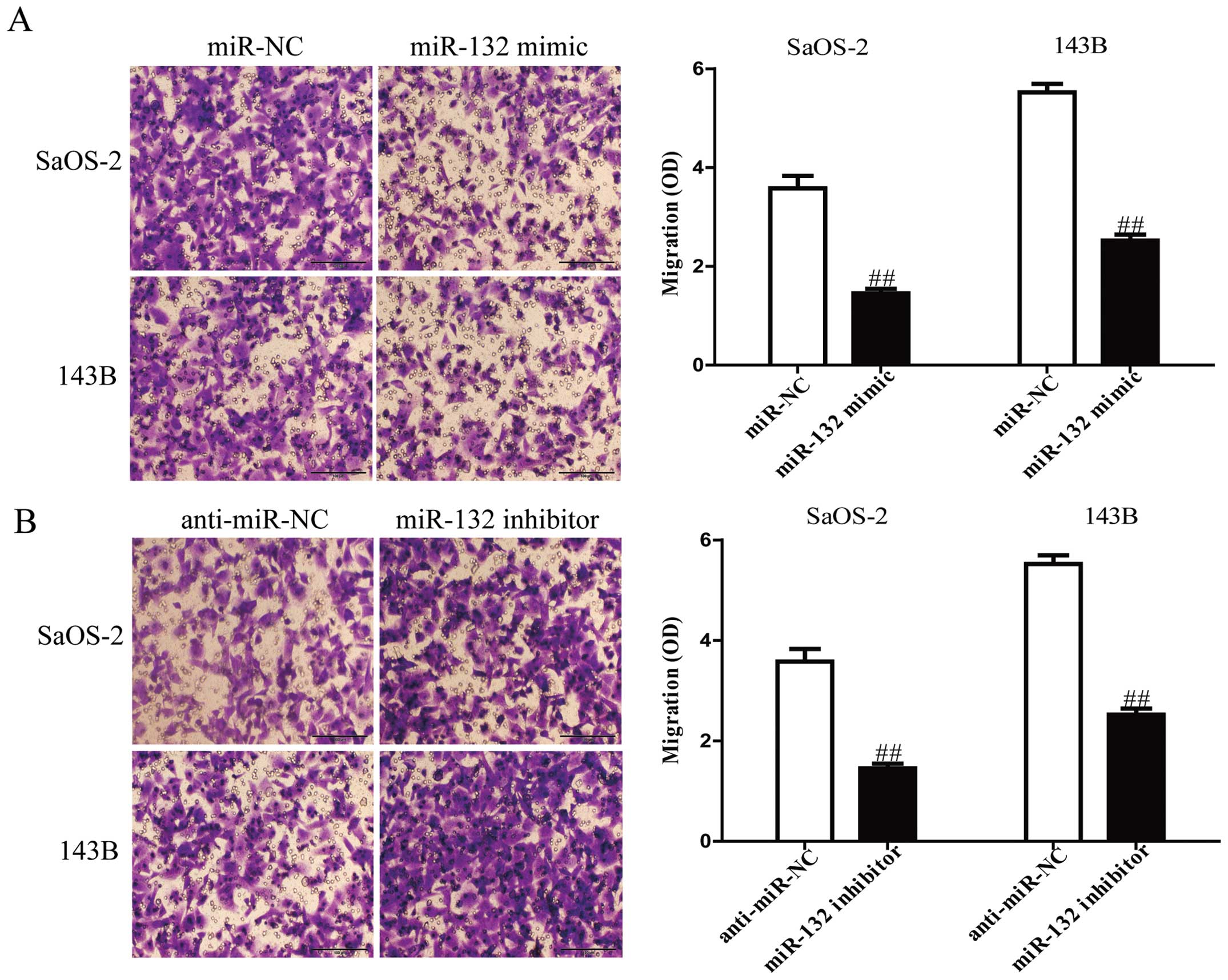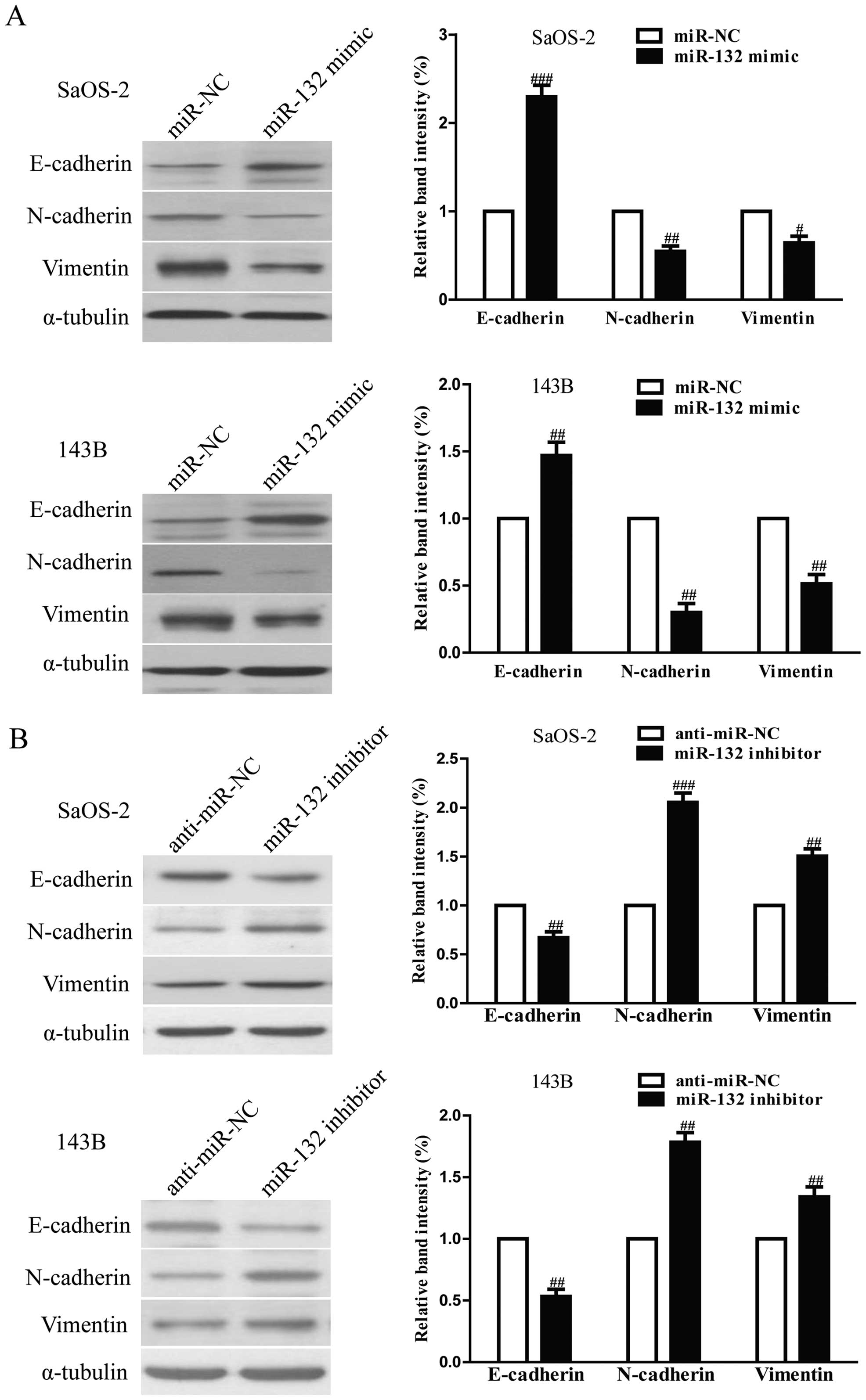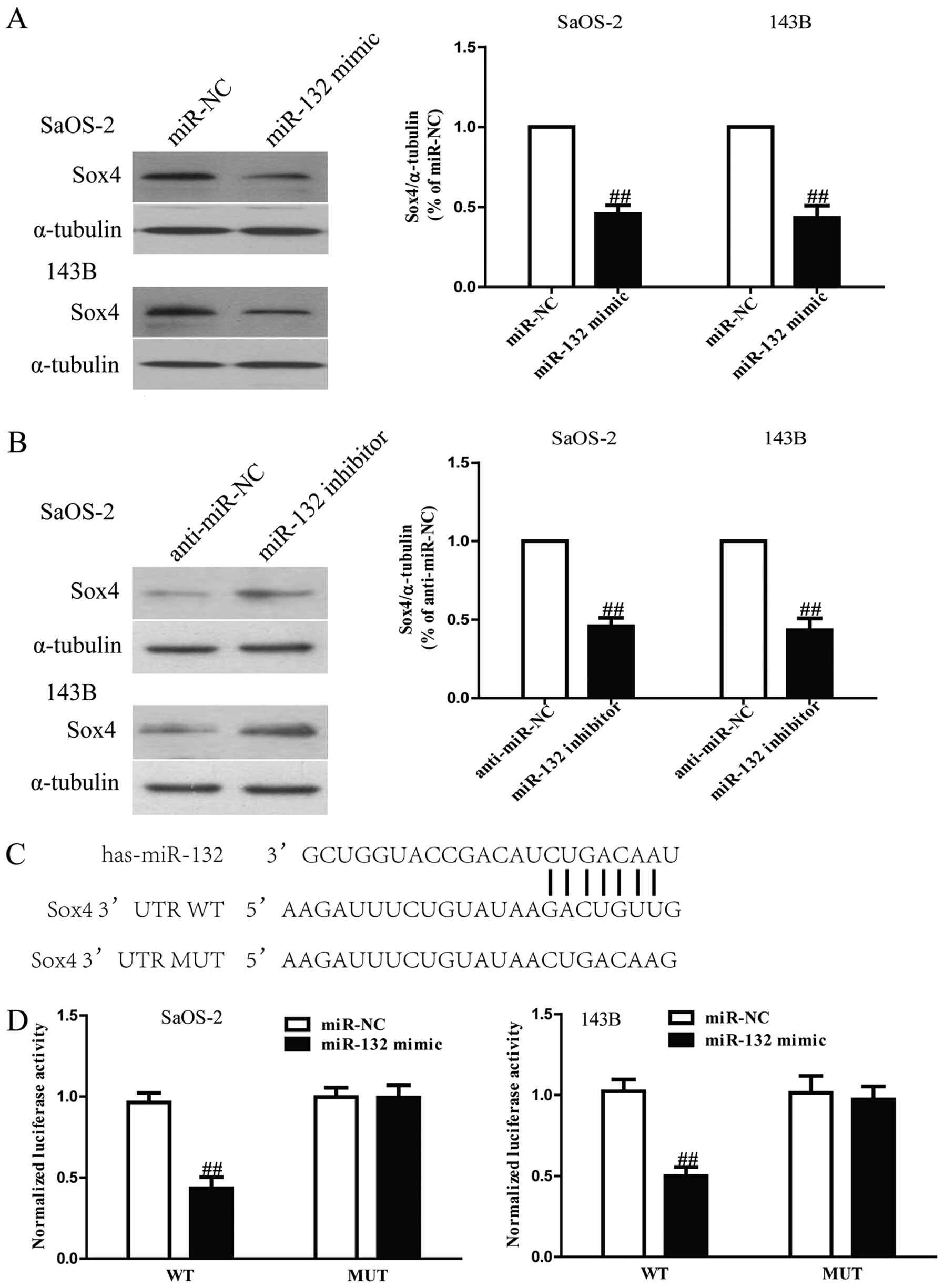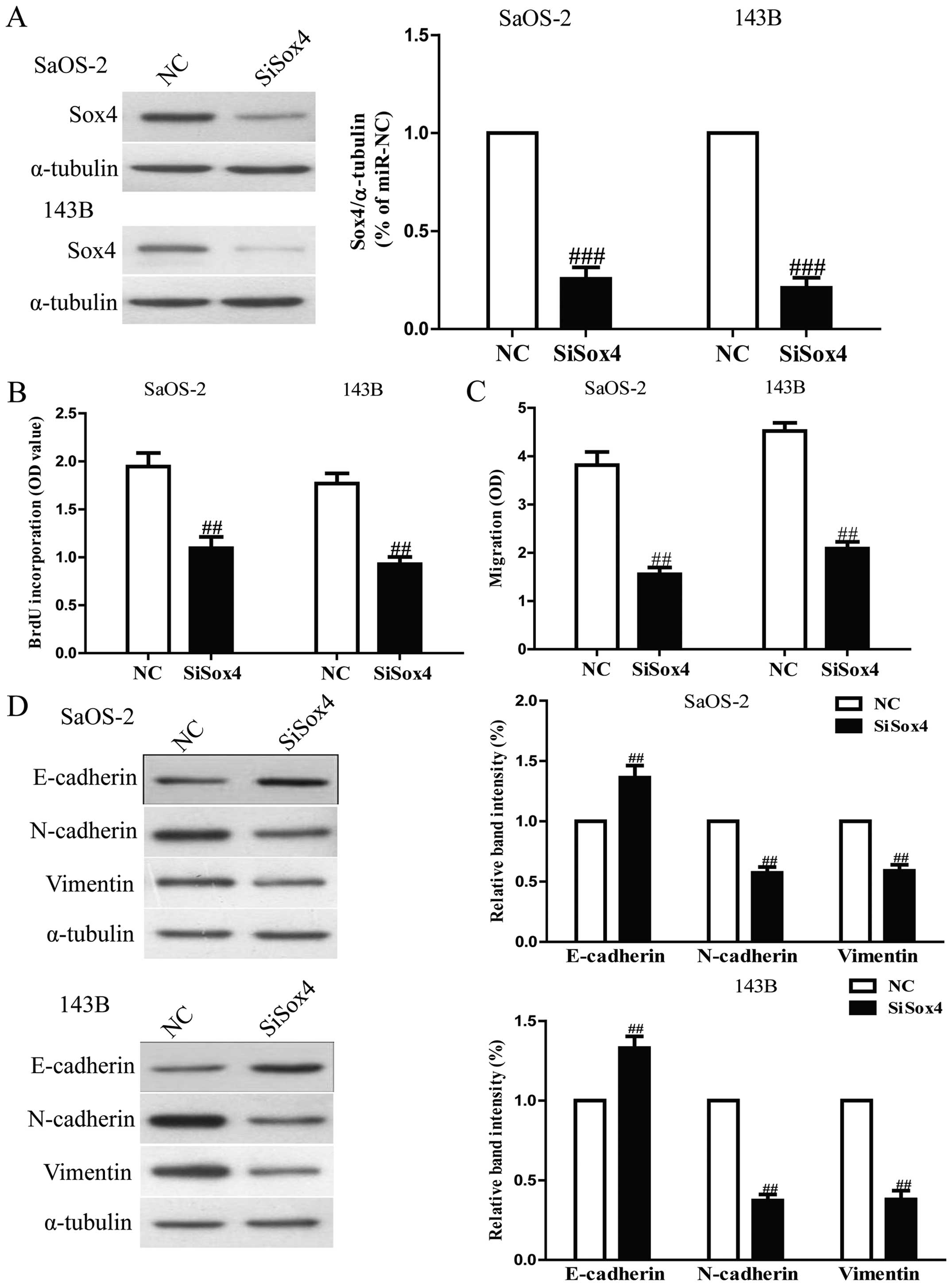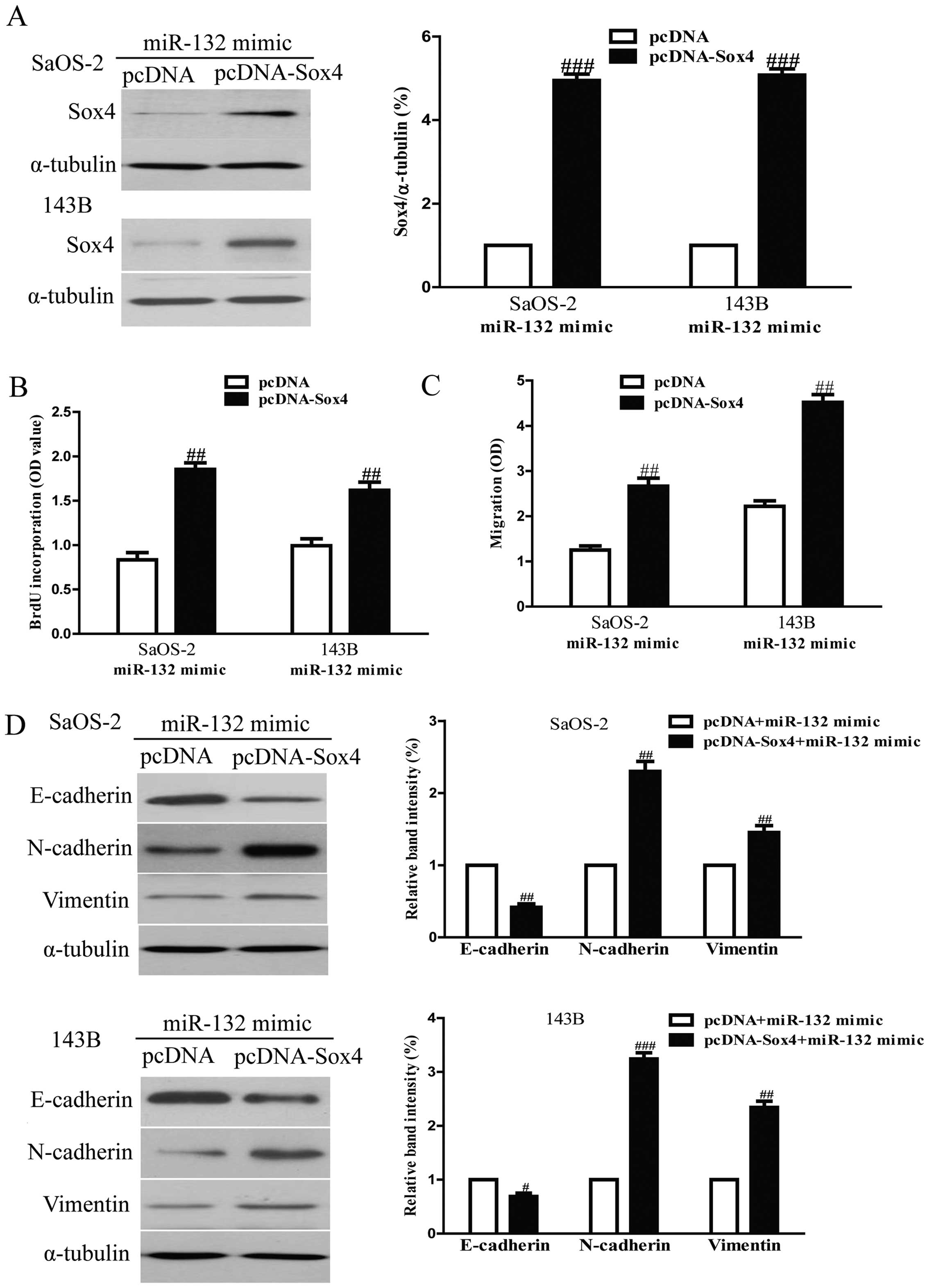MicroRNA-132 inhibits cell growth and metastasis in osteosarcoma cell lines possibly by targeting Sox4
Retraction in: /10.3892/ijo.2023.5537
- Authors:
- Published online on: September 7, 2015 https://doi.org/10.3892/ijo.2015.3147
- Pages: 1672-1684
-
Copyright: © Liu et al. This is an open access article distributed under the terms of Creative Commons Attribution License.
Abstract
Introduction
Osteosarcoma (OS) is the most common and primary bone tumor in children, adolescents and young adults (1). It happens mainly around areas with active bone growth and repairation. Emerging evidence indicates OS is induced by genetic and epigenetic alterations which disturb mesenchymal stem cells to differentiate into osteoblasts (2). Over the past decade, advances in OS therapy have improved patient outcomes (3), resulting in dramatic improvement in the 5-year survival rate of OS patients to ~60–70%. However, outcome is still poor and most of them will die due to local relapse or pulmonary metastases after surgical resection and intensive-chemotherapy (4,5). In recent years, many clinical features, including tumor size, surgical margin and response to chemotherapy, are useful prognostic factors for patients with osteosarcoma. However, they lack specificity and sensitivity, indicating that different genetic mechanisms may be operating and altering response to chemotherapy and metastatic capability in some tumors during the same clinical stage of the tumor (6). Consequently, it is required to ascertain precise molecular markers for screening osteosarcoma patients with poor prognosis, so as to provide them with more aggressive treatment at an early stage.
Sox4, a 47-kDa protein, is a member of the sex-determining region Y (SRY)-related high-mobility group (HMG)-box (Sox) transcription factor family. Recently, the clinical importance of Sox4 has gained increasing attention, and numerous reports indicated that Sox4 may act as oncogenic gene involved in multiple human malignancies, including hepatocellular, bladder, lung, colon, prostate, and gastric cancers, with poor prognostic features and advanced disease status (7–10). There are three distinguishable domains in Sox4 gene, which contain an HMG box, a serine-rich region, and a glycine-rich region. The HMG box acts as a DNA-binding domain, and the serine-rich domain acts as a transactivation domain (11). The glycine-rich region which is the central domain located between the HMG box and serine-rich domain acts as a novel functional region for promoting apoptotic cell death (12). In recent years, it has been reported that transcriptional targets of Sox4 are closely related to tumor progression and microRNA (miRNA) processing (11,13).
miRNAs are small (~22 nucleotides in length), non-coding RNAs (14), miRNAs degrade or suppress their translation and regulate a series of cell functions such as proliferation, apoptosis, invasion and differentiation, by binding to complementary sequences in the 3′UTRs of targeted mRNAs (15,16). More and more evidence suggests that miRNAs are involved in various kinds of tumors (17). Many miRNAs have been identified to act as tumor suppressors or oncogenes in osteosarcoma, which is dependent on the role of their target genes, including miR-300 (18), miR-182 (19), miR-1247 (20) and miR-217 (21). These outcomes show a strong basis for the importance of miRNAs in the pathogenesis of osteosarcoma and emphasize the implications of miRNAs in diagnosis, therapy, and prognosis of osteosarcoma.
At present, miR-132 has attracted much attention, because it has been reported that it is frequently downregulated and functions as a tumor suppressor in breast, lung, colorectal cancer and osteosarcoma (22–25), and is also upregulated and functions as an oncogene in glioma and gastric cancer (26,27). It has been shown that miR-132 inhibited proliferation, invasion, migration and metastasis of breast cancer by targeting hematopoietic- and neurologic-expressed sequence 1 (HN1) (22). Besides, miR-132 inhibited cell invasion in both lung and colorectal cancers via targeting the ZEB2 (23,24). Moreover, miR-132 suppressed cell proliferation in osteosarcoma cells by targeting cyclin E1 (28). However, until now, the precise mechanism of miR-132 in osteosarcoma remains unclear. In this investigation, we also determined frequent downregulation of miR-132 in osteosarcoma cell lines, which was consistent with a previous study (28). Overexpression of miR-132 inhibited cell proliferation, invasion and epithelial-mesenchymal transition (EMT) of osteosarcoma cells. Moreover, we found that Sox4, a novel tumor suppressor gene, was the direct target of miR-132 in osteosarcoma. Restoration of Sox4 reversed the inhibitory effects of miR-132. Therefore, our outcomes showed critical roles for miR-132 in the pathogenesis of osteosarcoma and suggested its possible application in tumor treatment.
Materials and methods
Cell culture
Osteosarcoma cell lines MG63, HOS, SaOS-2, 143B, U2OS and the human normal osteoblastic cell line hFOB1.19 cells were obtained from American Type Culture Collection (ATCC, Manassas, VA, USA). The osteosarcoma cells were cultured in RPMI-1640 (Gibco Co., New York, NY, USA) containing 10% fetal bovine serum (FBS, Gibco), 1% penicillin and streptomycin at 37°C in a humidified atmosphere of 5 on 0.1% gelatin-coated culture flasks. The hFOB1.19 human osteoblasts were cultured in DMEM/Ham's F-12 containing 10% FBS and geneticin (400 μg/ml) at 37°C in 5% CO2 incubator.
Transient transfection
The miR-132 mimic, miR-negative control of mimics (miR-NC), miR-132 inhibitor, miR-negative control of inhibitor (anti-miR-NC), siRNA for Sox4 (si-Sox4) and siRNA-negative control (NC) were synthesized and purified by Gene-Pharma (Shanghai, China). miR-132 mimic, miR-132 inhibitor, and si-Sox4 were transfected at a final concentration of 50 nM using Lipofectamine 2000 reagent (Invitrogen) following the manufacturer's protocols. Total RNA and protein were collected 24 h after transfection.
Reverse transcription polymerase chain reaction
Total RNA of SaOS-2 and 143B cells was isolated by TRIzol reagent (Invitrogen) following the manufacturer's protocol. RNA (2 μg) was used for gene-specific reverse transcription polymerase chain reaction (RT-PCR) using one-step RT-PCR kit (Qiagen, Venlo, The Netherlands) following the manufacturer's protocols. Denaturation was performed at 94°C for 3 min, annealing at 95°C for 1 min, and elongation at 94°C for 30 sec for 40 cycles, followed by 72°C for 5 min. The following primers were used: miR-132 forward, 5′-TGGATCCCCCCCA GTCCCCGTCCCTCAG-3′; reverse, 5′-TGAATTCGGATA CCTTGGCCGGGAGGAC-3′. U6 forward, 5′-CTCGCTTC GGCAGCACA-3′; reverse, 5′-AACGCTTCACGAATTTG CGT-3′. U6 was used for normalization. Each sample was assessed in triplicate.
Cell proliferation assay
To explore the effect of miR-132 on proliferation of SaOS-2 and 143B cells, 5×103 cells were seeded in 96-well plate and allowed to grow overnight in complete RPMI-1640 medium. The medium was then removed, and cells were transfected with miR-132 mimic or inhibitor for 24 h at 37°C. Cell Proliferation ELISA-BrdU (colorimetric) kit (Roche Diagnostics, USA) was used to detect the cell proliferation according to the manufacturer's protocols.
Cell cycle analysis
To detect cell cycle distribution, the SaOS-2 and 143B cells were transfected with miR-132 mimic or inhibitor for 24 h. After transfection, SaOS-2 and 143B cells were collected by trypsinization, washed with ice-cold PBS, and fixed in ice-cold 70% methanol overnight. Then, cells were centrifuged, resuspended in ice-cold phosphate-buffered saline (PBS), and incubated with RNase (Sigma Chemical Co., USA) for 30 min at 37°C, and then were incubated with propidium iodide (PI; Sigma) at room temperature for 30 min. The analyses of cell cycle distribution were performed by FACScan flow cytometer (BD Biosciences, San Jose, CA, USA).
Annexin V-FITC/PI analysis
SaOS-2 and 143B cells were transfected with miR-132 mimic or inhibitor for 24 h. After transfection, cells were harvested and washed twice in PBS and double-stained with Annexin V-FITC and PI by using the Annexin V-FITC Apoptosis Detection kit (BD Biosciences) following the manufacturer's protocols. Then, each sample was quantitatively analyzed at 488 nm emission and 570 nm excitation by FACSCalibur flow cytometer (BD Biosciences).
Transwell invasion assay
To determine cell invasion, Transwell matrigel invasion assay using Transwell chambers (8-mm pore size; Millipore) precoated with Matrigel (BD Biosciences, Franklin Lakes, NJ, USA) that contained extracellular matrix proteins was used following the manufacturer's protocol. In brief, 1×105 SaOS-2 and 143B cells transfected with miR-132 mimic or inhibitor were suspended in 200 μl RPMI-1640 containing 1% FBS and seeded on the upper chamber. RPMI-1640 (600 ml) containing 10% FBS was added to the lower chamber. After 24-h incubation at 37°C in a 5% CO2 atmosphere, cells that remained in the upper chamber were removed by cotton swabs and penetrating cells were fixed in methanol, and then stained with 0.1% crystal violet. Cell invasion was quantified by counting cells on the lower surface using phase contrast microscopy (Olympus IX83, Japan).
Western blot analysis
To extract the proteins, SaOS-2 and 143B cells were washed twice in cold PBS, and then lysed in RIPA lysis buffer (Beyotime Institute of Biotechnology Jiangsu, China) with protease inhibitor cocktail (Merk, Germany). The protein concentration of cell lysates was quantified by BCA kit (Beyotime Institute of Biotechnology), and 50 μg of each of proteins were separated by SDS-PAGE on 8% gels, and then transferred to a polyvinylidene fluoride (PVDF) membrane (Millipore, USA). The membranes were blocked in 5% shimmed milk diluted with Tri-buffered saline Tween-20 (TBST) (in mmol/l: Tris-HCl 20, NaCl 150, pH 7.5, 0.1% Tween-20) at room temperature for 1 h and incubated overnight at 4°C with primary antibody, respectively: anti-Sox4 (no. ab80261; 1:500; Abcam, USA); anti-cyclin D1 (no. 2978), anti-CDK4 (no. 12790), anti-Bcl-2 (no. 2870), anti-E-cadherin (no. 5296), anti-N-cadherin (no. 3195), anti-vimentin (no. 3390) (1:1,000; Cell Signaling Technology Inc., MA, USA). The membranes were then incubated with a goat anti-rabbit (no. 14708) or anti-mouse (no. 14709) IgG conjugated to horseradish peroxidase secondary antibody (1:1,000; Cell Signaling Technology) for 2 h. The proteins were visualized using ECL-plus reagents (Amersham Biosciences Corp., USA). The density of the bands was measured using ImageJ software (USA), and values were normalized to the densitometric values of α-tubulin (T5168; 1:1,000; Sigma) in each sample.
Luciferase reporter assay
SaOS-2 and 143B cells (1×105/well) were seeded in 24-well plates and incubated for one day before transfection. Cells were cotransfected with 0.5 μg pGL3-Sox4-3′UTR wild-type or mutant reporter plasmid, 50 nM miR-132 mimic or miR-NC, and 20 ng pRL-SV40 Renilla plasmid (Promega, USA) using Lipofectamine 2000. At 24 h after transfection, both firefly and Renilla luciferase activities were quantified using the Dual-Luciferase reporter system (Promega) according to the manufacturer's instructions. All experiments were performed in triplicate.
Statistical analysis
All statistical analyses were performed using GraphPad Prism 5.0 (GraphPad software, Inc., USA). Data from each group were expressed as mean ± standard error of the mean (SEM) and statistically analyzed by Student's t-test. Differences were considered statistically significant at a p-value of <0.05.
Results
The expression of miR-132 is downregulated in osteosarcoma cell lines
To determine the levels of miR-132 in OS cells, five osteosarcoma cell lines (MG63, HOS, SaOS-2, 143B and U2OS) and a human normal osteoblastic cell line (hFOB1.19) were used to detect the level of miR-132 by real time-PCR. Our results demonstrated that the level of miR-132 was significantly decreased in all five OS cell lines compared to that in human normal osteoblastic cell line hFOB1.19, as shown in Fig. 1. Among these OS cell lines, SaOS-2 and 143B cells were used for further study.
miR-132 inhibites cell proliferation, induces G1-phase arrest and cell apoptosis in both SaOS-2 and 143B cells
Based on the downregulation of miR-132, we believed that miR-132 could act as a suppressor of cell growth. After transfection with miR-132 mimic, the RT-PCR analysis showed that mRNA level of miR-132 was significantly upregulated in miR-132 mimic group compared to miR-NC group (Fig. 2A). These data demonstrated that we efficiently enhanced or reduced miR-132 expression in SaOS-2 and 143B cells. To determine the role of miR-132 in proliferation of osteosarcoma cells, the results from Brdu-ELISA assay demonstrated that overexpression of miR-132 dramatically inhibited the proliferation of SaOS-2 and 143B cells (Fig. 2B). Because miR-132 significantly inhibited proliferation of SaOS-2 and 143B cells, we speculated that miR-132 could induce cell cycle arrest in osteosarcoma cells, and proved this tentatively by flow cytometry. Our finding showed that upregulation of miR-132 induced a dramatic G1-phase arrest and decreased the percentage of cells in the S-phase in both SaOS-2 and 143B cells compared with cells transfected with miR-NC (Fig. 2C). Therefore, miR-132 might inhibit the proliferation of osteosarcoma cells by impeding the G1/S cell cycle transition. In order to explore whether pro-apoptosis participated in miR-132 mimic-induced anti-proliferative effect, the total apoptosis rates of SaOS-2 and 143B cells were detected by flow cytometry analysis. As shown in Fig. 2D, flow cytometry analysis showed that the number of apoptotic SaOS-2 and 143B cells was evidently higher in miR-132 mimic than that in miR-NC group. However, the cell proliferation and cell cycle were increased and cell apoptosis was inhibited in both SaOS-2 and 143B cells transfected with miR-132 inhibitor compared with anti-miR-NC group (Fig. 3).
The effects of miR-132 on the expressions of cell cycle and apoptosis-related proteins in osteosarcoma cells
To investigate the possible mechanism of miR-132 on cell proliferation, cell cycle and apoptosis, we tested the effects of miR-132 on several cell cycle and apoptosis-related molecules. As shown in Fig. 4A, upregulation of miR-132 decreased the protein levels of cyclin D1, CDK4 and Bcl-2 in SaOS-2 and 143B cells, which suggested that miR-132 inhibited cell proliferation, cell cycle and induced apoptosis by downregulation of cyclin D1, CDK4 and Bcl-2. In addition, downregulation of miR-132 increased expression of these proteins (Fig. 4B).
The effects of miR-132 on the invasion and EMT in osteosarcoma cells
To evaluate the effects of miR-132 on invasion and EMT in osteosarcoma cells, we further transfected miR-132 mimic or inhibitor into SaOS-2 and 143B cells, and the invasive capacities of SaOS-2 and 143B cells were evaluated by Transwell invasion chamber experiments. The results from Transwell assays showed that the number of invading SaOS-2 and 143B cells was significantly reduced in miR-132 mimic group compared to miR-NC group (Fig. 5A). However, miR-132 inhibitor could evidently increase the number of invading SaOS-2 and 143B cells (Fig. 5B). Furthermore, we examined the effect of miR-132 mimic or inhibitor on the expressions of EMT markers in SaOS-2 and 143B cells using western blotting. Overexpression of miR-132 was able to upregulate the expression of epithelial marker E-cadherin, and downregulate the expression of mesenchymal markers N-cadherin and vimentin in SaOS-2 and 143B cells (Fig. 6A), but the miR-132 inhibitor had the opposing effects on these EMT expression markers (Fig. 6B). Taken together, our results indicated that miR-132 was able to inhibit the invasion and EMT in osteosarcoma cells.
Sox4 is a direct target of miR-132 in osteosarcoma cells
Since Sox4 was a binding target of miR-132 predicted by the online database, TargetScan 6.2, we performed western blotting and RT-PCR to observe the expression of Sox4 on protein level in SaOS-2 and 143B cells transfected with miR-132 mimic or inhibitor. Our results showed that protein level of Sox4 was remarkably decreased after upregulation of miR-132 (Fig. 7A), but was evidently increased after downregulation of miR-132 (Fig. 7B). To further demonstrate whether Sox4 was a direct target of miR-132, Sox4 3′-UTR was cloned into a luciferase reporter vector and the putative miR-132 binding site in the Sox4 3′-UTR was mutated (Fig. 7C). The effect of miR-132 was determined using luciferase reporter assay. The results showed that overexpression of miR-132 significantly inhibited the luciferase activity of pGL3-Sox4 3′-UTR WT (Fig. 7D). Mutation of the miR-132-binding site in the Sox4 3′-UTR abolished the effect of miR-132, which suggested that Sox4 was directly and negatively regulated by miR-132.
Downregulation of Sox4 by siRNA had similar effects with miR-132 overexpression
To explore the function of Sox4 in osteosarcoma cells, SaOS-2 and 143B cells were transfected with si-Sox4. Western blot analysis indicated that protein expression of Sox4 was significantly decreased after 24 h in both SaOS-2 and 143B cells transfected with si-Sox4 (Fig. 8A). The Brdu-ELISA assay revealed that downregulation of Sox4 also inhibited osteosarcoma cell proliferation (Fig. 8B). Furthermore, Transwell assay suggested that down-regulation of Sox4 expression inhibited invasion capability of osteosarcoma cells (Fig. 8C). Downregulation of Sox4 resulted in upregulation of the epithelial marker E-cadherin, and downregulation of the mesenchymal markers N-cadherin and vimentin (Fig. 8D). Sox4 silencing induced a very similar phenotype to miR-132 expression in osteosarcoma cells. These results indicated that miR-132 downregulated Sox4, thus inhibiting osteosarcoma cell growth and metastasis.
Suppression of Sox4 is essential for miR-132-inhibited cell proliferation, invasion and EMT in osteosarcoma cells
To determine whether miR-132 reduced the proliferation, invasion and EMT of osteosarcoma cells in a Sox4-dependent manner, we cotransfected SaOS-2 and 143B cells with miR-132 mimic and pcDNA3.1-Sox4 vector. We found that the expression of Sox4 was significantly increased after transfection with miR-132 and pcDNA-Sox4 compared with miR-132 and pcDNA vector in both SaOS-2 and 143B cells (Fig. 9A). Analysis by Brdu-ELISA assay indicated that overexpression of Sox4 in cells transfected with the miR-132 mimic enhanced the proliferation of osteosarcoma cells (Fig. 9B). The Transwell assay showed that upregulating Sox4 expression could reverse the inhibitory effect of the miR-132 mimic on invasion of osteosarcoma cells (Fig. 9C). Moreover, increased Sox4 expression downregulated the expression of epithelial marker E-cadherin, and upregulated the expression of mesenchymal marker N-cadherin and vimentin in SaOS-2 and 143B cells transfected with miR-132 mimic (Fig. 9D). Therefore, the inhibitory effects of miR-132 were reversed by Sox4 overexpression. Our results clearly demonstrated that miR-132 inhibited cell proliferation, invasion and EMT in osteosarcoma cells by downregulation of Sox4, and that knockdown of Sox4 was essential for the miR-132-inhibited cell proliferation, invasion and EMT in osteosarcoma cells.
Discussion
The miRNAs have been reported as important regulators involved in different biological processes such as cell proliferation, metastasis, differentiation, transcriptional regulation and tumorigenesis (29). Globally miRNA dysregulation of tumors have provided major insights into the molecular mechanisms of neoplasia (30). As one of the most prominent miRNAs implicated in tumorigenesis, miR-132 has been presented with a controversial role during tumor progression (31). miR-132 was found to be decreased in many human cancers, including breast, lung, colorectal cancers and osteosarcoma (22–25), but increased in glioma and gastric cancer (26,27). The precise mechanism of miR-132 in osteosarcoma remained unclear. Therefore, in this study, we aimed to elucidate the biological functions and its mechanism of miR-132 in osteosarcoma. Our results demonstrated that miR-132 was frequently downregulated in osteosarcoma cell lines compared to human normal osteoblastic cells. According to these findings, we speculated that miR-132 might be a potential anti-oncogene in osteosarcoma, which was consistent with a previous study (28). As expected, upregulation of miR-132 inhibited proliferation, invasion, EMT and induced apoptosis of SaOS-2 and 143B cells. Our current findings indicate that miR-132 played important roles in regulation of proliferation, apoptosis, invasion and metastasis in osteosarcoma and may be potential diagnostic and predictive biomarkers.
We also explored the exact molecular mechanism of miR-132 in suppressing proliferation, invasion, EMT and inducing apoptosis in osteosarcoma cells. As a result, the real-time PCR, western blotting and luciferase reporter assay demonstrated that Sox4 is a direct target of miR-132. Importantly, we also showed that the proliferation-, invasion- and EMT-inhibiting effects of miR-132 overexpression were partly reversed by upregulating Sox4 expression. Thus, we confirmed that miR-132 played critical roles in the inhibition of proliferation, invasion and metastasis in osteosarcoma cells, partially by downregulating the protein expression of Sox4.
In this study, Brdu-ELISA assays showed that overexpression of miR-132 was able to significantly inhibit the proliferation of SaOS-2 and 143B cells. Cell cycle analyses also showed that the percentage of cells in the G1-phase was increased and the percentage of cells in the S-phase was decreased in cells transfected with miR-132 mimic compared to cells transfected with miR-NC. Moreover, flow cytometry analysis demonstrated that miR-132 mimic could evidently induce apoptosis of SaOS-2 and 143B cells compared with miR-NC group. However, the cell proliferation and cell cycle were increased and cell apoptosis was inhibited in both SaOS-2 and 143B cells transfected with miR-132 inhibitor compared with anti-miR-NC group. It is known that cell cycle progression and apoptosis are regulated by numerous proteins. To confirm the possible mechanism of miR-132 on regulation of cell cycle and apoptosis, we investigated the effects of miR-132 mimic or inhibitor on cell cycle- and apoptosis-related proteins. We detected the expression of cyclin D1, CDK4 and Bcl-2. From our data, we found that upregulation or downregulation of miR-132 decreased or increased the protein levels of cyclin D1, CDK4 and Bcl-2, respectively. Cyclin D1 interacts with CDK4 to form the cyclin D-CDK4 complex, and then phosphorylates Rb, which plays a critical role in carcinogenesis. The cyclin-D1/CDK4/p-Rb pathway has been proved to be changed in most of human cancers (32,33). It is a pivotal regulator of the G1 to S phase transition of the cell cycle. Bcl-2, an anti-apoptotic protein, is considered to be resistant to conventional treatment of cancer (34,35). In this report, our finding showed that miR-132 mimic reduced Bcl-2 protein and miR-132 inhibitor increased Bcl-2 protein, which indicated that miR-132 regulated cell apoptosis via Bcl-2 modulation. Altogether, these outcomes indicated that miR-132 affected the cell cycle and apoptosis by regulating cyclin D1, CDK4 and Bcl-2. In addition, Transwell assay showed that miR-132 mimic or inhibitor dramatically inhibited or enhanced the invasion of SaOS-2 and 143B cells compared with miR-NC or anti-miR-NC group, respectively. Furthermore, we determined the change of EMT markers in SaOS-2 and 143B cells transfected with miR-132 mimic or inhibitor. Our results showed that upregulation of miR-132 could markedly suppress invasive ability of osteosarcoma cells by dramatically upregulating the epithelial marker E-cadherin and downregulating the mesenchymal marker N-cadherin and vimentin, and miR-132 inhibitor had the opposing effect on expression of EMT markers, which supported that miR-132 might suppress the EMT process to restrain cell invasion and metastasis.
At the molecular level, our results demonstrated that Sox4 was a direct target of miR-132 in osteosarcoma cells. Some reports have indicated that overexpression of Sox4 exists in multiple human cancers, including endometrial (36), esophageal (37), ovarian (38), gastric cancers (39) and osteosarcoma (28), suggesting that Sox4 might be a vital oncogene affecting progression and metastasis of tumors. In the present study, Sox4 was also found to be upregulated in osteosarcom cells. Furthermore, we found that knockdown of Sox4 using siRNA oligos inhibited the proliferation, invasion and EMT of osteosarcoma cells, which had similar effects with miR-132 overexpression. Besides, restoration of Sox4 reversed the inhibitory effects of miR-132, suggesting that Sox4 may play a critical role in osteosarcoma progression and metastasis.
In conclusion, our results indicate that miR-132 was dramatically downregulated in osteosarcoma cells. Overexpression of miR-132 inhibited proliferation, invasion, EMT and induced apoptosis of osteosarcoma cells through directly targeting Sox4. This novel miR-132/Sox4 axis might provide new insights into the molecular mechanisms underlying progression and metastasis of tumors, and upregulation of miR-132 expression might be a possible therapeutic strategy for the therapy of osteosarcoma in the future.
References
|
Mirabello L, Troisi RJ and Savage SA: Osteosarcoma incidence and survival rates from 1973 to 2004: Data from the Surveillance, Epidemiology, and End Results Program. Cancer. 115:1531–1543. 2009. View Article : Google Scholar : PubMed/NCBI | |
|
Yan K, Gao J, Yang T, Ma Q, Qiu X, Fan Q and Ma B: MicroRNA-34a inhibits the proliferation and metastasis of osteosarcoma cells both in vitro and in vivo. PLoS One. 7:e337782012. View Article : Google Scholar : PubMed/NCBI | |
|
Amankwah EK, Conley AP and Reed DR: Epidemiology and therapies for metastatic sarcoma. Clin Epidemiol. 5:147–162. 2013.PubMed/NCBI | |
|
Bacci G, Briccoli A, Rocca M, Ferrari S, Donati D, Longhi A, Bertoni F, Bacchini P, Giacomini S, Forni C, et al: Neoadjuvant chemotherapy for osteosarcoma of the extremities with metastases at presentation: Recent experience at the Rizzoli Institute in 57 patients treated with cisplatin, doxorubicin, and a high dose of methotrexate and ifosfamide. Ann Oncol. 14:1126–1134. 2003. View Article : Google Scholar : PubMed/NCBI | |
|
Rainusso N, Wang LL and Yustein JT: The adolescent and young adult with cancer: State of the art - bone tumors. Curr Oncol Rep. 15:296–307. 2013. View Article : Google Scholar : PubMed/NCBI | |
|
Szuhai K, Cleton-Jansen AM, Hogendoorn PC and Bovée JV: Molecular pathology and its diagnostic use in bone tumors. Cancer Genet. 205:193–204. 2012. View Article : Google Scholar : PubMed/NCBI | |
|
Pramoonjago P, Baras AS and Moskaluk CA: Knockdown of Sox4 expression by RNAi induces apoptosis in ACC3 cells. Oncogene. 25:5626–5639. 2006. View Article : Google Scholar : PubMed/NCBI | |
|
Medina PP, Castillo SD, Blanco S, Sanz-Garcia M, Largo C, Alvarez S, Yokota J, Gonzalez-Neira A, Benitez J, Clevers HC, et al: The SRY-HMG box gene, SOX4, is a target of gene amplification at chromosome 6p in lung cancer. Hum Mol Genet. 18:1343–1352. 2009. View Article : Google Scholar : PubMed/NCBI | |
|
Liao YL, Sun YM, Chau GY, Chau YP, Lai TC, Wang JL, Horng JT, Hsiao M and Tsou AP: Identification of SOX4 target genes using phylogenetic footprinting-based prediction from expression microarrays suggests that overexpression of SOX4 potentiates metastasis in hepatocellular carcinoma. Oncogene. 27:5578–5589. 2008. View Article : Google Scholar : PubMed/NCBI | |
|
Liu P, Ramachandran S, Ali Seyed M, Scharer CD, Laycock N, Dalton WB, Williams H, Karanam S, Datta MW, Jaye DL, et al: Sex-determining region Y box 4 is a transforming oncogene in human prostate cancer cells. Cancer Res. 66:4011–4019. 2006. View Article : Google Scholar : PubMed/NCBI | |
|
Scharer CD, McCabe CD, Ali-Seyed M, Berger MF, Bulyk ML and Moreno CS: Genome-wide promoter analysis of the SOX4 transcriptional network in prostate cancer cells. Cancer Res. 69:709–717. 2009. View Article : Google Scholar : PubMed/NCBI | |
|
Dy P, Penzo-Méndez A, Wang H, Pedraza CE, Macklin WB and Lefebvre V: The three SoxC proteins - Sox4, Sox11 and Sox12 - exhibit overlapping expression patterns and molecular properties. Nucleic Acids Res. 36:3101–3117. 2008. View Article : Google Scholar : PubMed/NCBI | |
|
Tavazoie SF, Alarcón C, Oskarsson T, Padua D, Wang Q, Bos PD, Gerald WL and Massagué J: Endogenous human microRNAs that suppress breast cancer metastasis. Nature. 451:147–152. 2008. View Article : Google Scholar : PubMed/NCBI | |
|
Bartel DP: MicroRNAs: Genomics, biogenesis, mechanism, and function. Cell. 116:281–297. 2004. View Article : Google Scholar : PubMed/NCBI | |
|
Kim VN, Han J and Siomi MC: Biogenesis of small RNAs in animals. Nat Rev Mol Cell Biol. 10:126–139. 2009. View Article : Google Scholar : PubMed/NCBI | |
|
Thomson DW, Bracken CP and Goodall GJ: Experimental strategies for microRNA target identification. Nucleic Acids Res. 39:6845–6853. 2011. View Article : Google Scholar : PubMed/NCBI | |
|
Wiemer EA: The role of microRNAs in cancer: No small matter. Eur J Cancer. 43:1529–1544. 2007. View Article : Google Scholar : PubMed/NCBI | |
|
Xue Z, Zhao J, Niu L, An G, Guo Y and Ni L: Up-regulation of miR-300 promotes proliferation and invasion of osteosarcoma by targeting BRD7. PLoS One. 10:e01276822015. View Article : Google Scholar : PubMed/NCBI | |
|
Hu J, Lv G, Zhou S, Zhou Y, Nie B, Duan H, Zhang Y and Yuan X: The downregulation of MiR-182 is associated with the growth and invasion of osteosarcoma cells through the regulation of TIAM1 expression. PLoS One. 10:e01211752015. View Article : Google Scholar : PubMed/NCBI | |
|
Zhao F, Lv J, Gan H, Li Y, Wang R, Zhang H, Wu Q and Chen Y: MiRNA profile of osteosarcoma with CD117 and stro-1 expression: miR-1247 functions as an onco-miRNA by targeting MAP3K9. Int J Clin Exp Pathol. 8:1451–1458. 2015.PubMed/NCBI | |
|
Sun B, Yang M, Li M and Wang F: The microRNA-217 functions as a tumor suppressor and is frequently downregulated in human osteosarcoma. Biomed Pharmacother. 71:58–63. 2015. View Article : Google Scholar : PubMed/NCBI | |
|
Zhang ZG, Chen WX, Wu YH, Liang HF and Zhang BX: MiR-132 prohibits proliferation, invasion, migration, and metastasis in breast cancer by targeting HN1. Biochem Biophys Res Commun. 454:109–114. 2014. View Article : Google Scholar : PubMed/NCBI | |
|
You J, Li Y, Fang N, Liu B, Zu L, Chang R, Li X and Zhou Q: MiR-132 suppresses the migration and invasion of lung cancer cells via targeting the EMT regulator ZEB2. PLoS One. 9:e918272014. View Article : Google Scholar : PubMed/NCBI | |
|
Zheng YB, Luo HP, Shi Q, Hao ZN, Ding Y, Wang QS, Li SB, Xiao GC and Tong SL: miR-132 inhibits colorectal cancer invasion and metastasis via directly targeting ZEB2. World J Gastroenterol. 20:6515–6522. 2014. View Article : Google Scholar : PubMed/NCBI | |
|
Yang J, Gao T, Tang J, Cai H, Lin L and Fu S: Loss of microRNA-132 predicts poor prognosis in patients with primary osteosarcoma. Mol Cell Biochem. 381:9–15. 2013. View Article : Google Scholar : PubMed/NCBI | |
|
Liu Q, Liao F, Wu H, Cai T, Yang L, Wang ZF and Zou R: Upregulation of miR-132 expression in glioma and its clinical significance. Tumour Biol. 35:12299–12304. 2014. View Article : Google Scholar : PubMed/NCBI | |
|
Liu X, Yu H, Cai H and Wang Y: The expression and clinical significance of miR-132 in gastric cancer patients. Diagn Pathol. 9:572014. View Article : Google Scholar : PubMed/NCBI | |
|
Wang J, Xu G, Shen F and Kang Y: miR-132 targeting cyclin E1 suppresses cell proliferation in osteosarcoma cells. Tumour Biol. 35:4859–4865. 2014. View Article : Google Scholar : PubMed/NCBI | |
|
Wu WK, Lee CW, Cho CH, Fan D, Wu K, Yu J and Sung JJ: MicroRNA dysregulation in gastric cancer: A new player enters the game. Oncogene. 29:5761–5771. 2010. View Article : Google Scholar : PubMed/NCBI | |
|
Miao J, Wu S, Peng Z, Tania M and Zhang C: MicroRNAs in osteosarcoma: Diagnostic and therapeutic aspects. Tumour Biol. 34:2093–2098. 2013. View Article : Google Scholar : PubMed/NCBI | |
|
Yin J, Lin J, Luo X, Chen Y, Li Z, Ma G and Li K: miR-137: A new player in schizophrenia. Int J Mol Sci. 15:3262–3271. 2014. View Article : Google Scholar : PubMed/NCBI | |
|
Vogelstein B and Kinzler KW: Cancer genes and the pathways they control. Nat Med. 10:789–799. 2004. View Article : Google Scholar : PubMed/NCBI | |
|
Nevins JR: The Rb/E2F pathway and cancer. Hum Mol Genet. 10:699–703. 2001. View Article : Google Scholar : PubMed/NCBI | |
|
Yao Q, Chen J, Lv Y, Wang T, Zhang J, Fan J and Wang L: The significance of expression of autophagy-related gene Beclin, Bcl-2, and Bax in breast cancer tissues. Tumour Biol. 32:1163–1171. 2011. View Article : Google Scholar : PubMed/NCBI | |
|
Korbakis D and Scorilas A: Quantitative expression analysis of the apoptosis-related genes BCL2, BAX and BCL2L12 in gastric adenocarcinoma cells following treatment with the anticancer drugs cisplatin, etoposide and taxol. Tumour Biol. 33:865–875. 2012. View Article : Google Scholar : PubMed/NCBI | |
|
Huang YW, Liu JC, Deatherage DE, Luo J, Mutch DG, Goodfellow PJ, Miller DS and Huang TH: Epigenetic repression of microRNA-129-2 leads to overexpression of SOX4 oncogene in endometrial cancer. Cancer Res. 69:9038–9046. 2009. View Article : Google Scholar : PubMed/NCBI | |
|
Kang M, Li Y, Liu W, Wang R, Tang A, Hao H, Liu Z and Ou H: miR-129-2 suppresses proliferation and migration of esophageal carcinoma cells through downregulation of SOX4 expression. Int J Mol Med. 32:51–58. 2013.PubMed/NCBI | |
|
Yeh YM, Chuang CM, Chao KC and Wang LH: MicroRNA-138 suppresses ovarian cancer cell invasion and metastasis by targeting SOX4 and HIF-1α. Int J Cancer. 133:867–878. 2013. View Article : Google Scholar : PubMed/NCBI | |
|
Zhou X, Li L, Su J and Zhang G: Decreased miR-204 in H pylori-associated gastric cancer promotes cancer cell proliferation and invasion by targeting SOX4. PLoS One. 9:e1014572014. View Article : Google Scholar |



